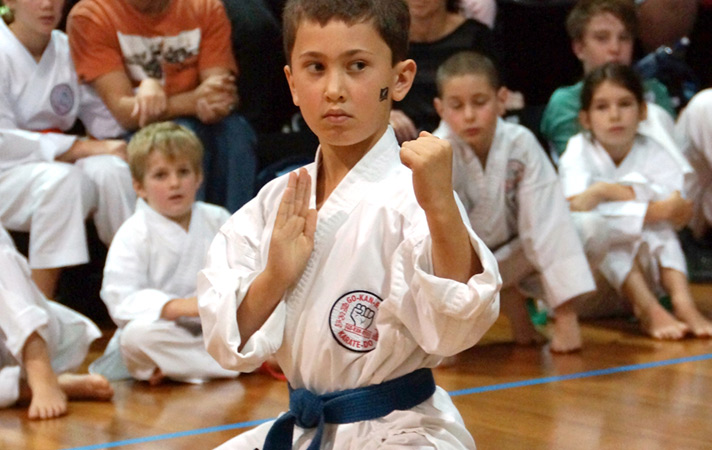Understanding Kata And Its Relationship To Bunkai
While kata is regarded as the ‘art form’ of karate, the original premise behind all kata is self-defense. Behind each technique lies multiple hidden self-defense application/s. The application of the techniques within kata is known as ‘Bunkai’.
Often, when studying or practicing Bunkai, students try to emulate or resemble the kata as close as possible. In other words, they try to achieve the means without compromising the kata – maintaining formal stances, perfect posture etc. The reason many emulate kata to this degree of detail when practising Bunkai, is due to the way they see the development of Kata. A case of the chicken before the egg; students often see the Kata being the original concept (the egg). They see a kata first being developed and only later, after studying the Kata in detail, could a self-defence meaning be unearthed. While this is true in some sense, people who see the Kata as the egg will tend to show the Kata clearly in Bunkai.
“Kata is both a method of self-defence AND an art form. And while it is two things, they do not have to resemble one another.”
This is not how bunkai is intended to be. One must note that kata is both a method of self-defence AND an art form, and while it is two things they do not have to resemble one another. The actuality is this; the self-defence technique was the egg. The karate forefathers had been training in karate for years before introducing their own kata. Over the years they learnt many self-defence techniques, and in that time developed techniques they swore by and may have even used in self-defence. As the years passed they would formulate a kata based on capturing their fighting philosophies. This is why kata can be seen as a study of history and people.
Lets take a few case studies. Sokon ‘Bushi’ Matsumura is regarded as the first person in Okinawa to teach kata Bassai-Dai. He was the Chief bodyguard to the King and responsible for training the King’s guards. Spending time in Royal grounds, the most likely time he or his men would ever need self-defense was when the town’s people would riot. Now let us examine the techniques of Bassai-dai. It involves fast techniques with quick changes in direction (as if negotiating a rioting crowd). The kata, therefore, illustrates his fighting philosophies. To study a kata developed by Chojun Miyagi (founder of Goju Ryu), one can get a look into this famous master’s fighting style and favoured techniques. Even to study Kancho Sullivan’s two original kata, you can clearly see Kancho’s fighting style come out, in other words, the techniques he would be most confident with in self-defence.
Meeting Kata Criteria
The question many ask is, did these masters intend the bunkai to look exactly like the kata? The answer is no. Remember, the kata is not the egg, the technique is. So if a self-defence technique was to be put into kata it had to meet the criteria for a kata. Kata has formalised stances, formalised hand positioning, perfect posture and clean angles (0, 45, 90 degrees etc). So the techniques had to be modified to fit. What’s more, kata is ultimately an art form, so techniques were changed again in their timing. This tells us by the time a self-defence technique made its way into a kata it no longer resembled its original shape.
“Bunkai takes from kata but need not be kata.”
So why would they do this? Why would they not simply stick to teaching self-defence techniques as they were? In many cases self-defence techniques are taught separately – as they can be done. But when it comes to those in kata, there are numerous reasons.
Firstly, the self-defence applications in kata were made abstract purposefully to hide their true meanings. It was unacceptable to teach a novice lethal techniques before they had revealed pure motives for learning. While they learned basic fighting skills in ‘basic training’, the more lethal techniques hidden in kata were only revealed as they developed their true understanding of karate.
Secondly, one aim of karate was self- mastery. With no formalised structure (eg the front knee placed directly over the foot in long forward stance) there would be no way of charting ones progress. By having formalised kata, it was easy to gauge how successfully a practitioner was mastering control over their body.
Thirdly, many of the postures (such as deep stances) in kata were designed for physical conditioning. To be capable of defending one’s self, knowledge only goes so far as the body itself had to be forged into a weapon. It is interesting to note when studying the Japanese symbol for Kata, that the upper part of the symbol ‘Kei’ means punishment. This symbol sits over another symbol, ‘Doh’ meaning earth or soil. Combined, it roughly translates to strictly imposed, physical punishment taking place outside on the ground.
All this backs up the earlier statement, that while kata is both a method of self-defence AND an art form, these two things do not have to resemble one another. Understanding that kata is the end-result of a self-defence technique, we come to realise the kata can and should be compromised to make Bunkai more effective. Just as self-defence is not so apparent in a kata, kata should not be so apparent in a Bunkai application.
Bunkai Training Involves Compromise
The conditions go unchanged in kata, yet in real life, very few opponents will stand in their forward stance with their arm outstretched awaiting your next move. This implies compromise has to be made.
Be Distance Adaptable
Many times you’ll discover in your Bunkai training that you are too far away or too close to execute a fully effective technique. Distance is one of the most important factors in self- defence, thus where distance is out, you should always be willing and ready to correct it. When too far, take an extra step in, add a kick on the way in or even try pulling your opponent inwards. When you are too close for your desired technique to be effective, you may have to change a hand strike to an elbow technique, push them back to create the room or even shove them with your body if very close.
Be Target Adaptable
A kata might depict a body level punch, but you may find in class that your bunkai partner’s arm is in the way of your target. Adaptability is also a key factor in self-defense and where a target is covered; always be willing and ready to change techniques. In such an instance you might deliver your punch to the face or opt for a knife hand strike to the temple.
Be Ready To Add Techniques
A kata may depict a single hand or foot technique. Likely, the kata suggests that you put 100% commitment behind that technique to completely disable your opponent. In life however, there’s always something that may go wrong. You may hit the stomach instead of the solar plexus, the forehead instead of the nose; you may have poor distance rendering the technique weaker etc. Another key factor of self-defence is what the Japanese call ‘Zanshin’ (a continued state of awareness). The aim of bunkai training is self-defence effectiveness, so any time you feel your technique may not have met success, be ready to add techniques. Always be sure you and your partner are careful and aware that extra techniques may come if completely necessary.
Forget The Rules Of Kumite
When people practise bunkai, they often subconsciously lean their techniques towards the rules of kumite. Don’t be afraid to make a front kick to the stomach a groin kick, or a body punch a throat punch. In any such instance BE VERY CAREFUL, you do not wish to injure your training partner.
Forget Formalised Stances
While the Kata may involve ‘Sanchin’ or ‘Zenkutsu’ stances, the Bunkai being self-defense orientated need not have perfect stances. In Bunkai training, your stance guide should generally be your distance. If you are close, a shorter fighting stance is ideal, if you are further away, pressing in with a regular fighting stance is ideal. Where you are side on, a relaxed horse or sumo stance can be applied. Whatever the case, the focus is on effectiveness, not Kata. But remember, while your stances need not be formal, a deep- grounded stance is the base of a powerful strike.
Forget Formalised Posture And Hands
During kata, our posture is always straight. In part because good posture is in alignment with good health, and the better the posture the more powerful the technique. That said, there may be times in bunkai training where it is necessary to lean forward in a punch to gain more reach or duck a potential oncoming attack. Furthermore, where kata sees our returning hand come back to the hip, you may feel more secure keeping your returning hand in front of your body or jaw as protection.
The final note is that bunkai takes from kata but need not be kata. Your focus in bunkai should be different to kata. A kata focus is on successfully mastering your body – hence the need to strictly adhere to the formal path laid out. Bunkai’s focus, on the other hand, is on successfully mastering your opponent – hence the need to be adaptable to the path laid out.




